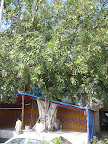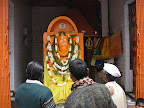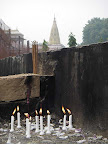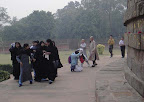
Before embarking on my first journey to India I was completely unprepared as to the ways of the country. Since I was invited on this trip, I was relying on the expertise of my traveling companions, who had been researching this trip for over a year. I decided to just concentrate on giving a good concert in Mumbai, and work on not getting lost before meeting up with my friends a few days later in Northern India. It was the day of departure, I was in the JFK airport walking toward the security checkpoint of the Air India terminal, armed with a small thin booklet on Indian Buddhist sites and a last-minute printout of the Wikipedia article on the Indian train system. I saw a mass of Indian people crowded in front of the checkpoint area. Two airport security people directed the traffic, checked tickets, and yelled instructions over the hum of the crowd. It looked like complete chaos. A long line cluster wound down along the duty free shops. How could there be so many people waiting to board my flight? I was two hours early.
A young Indian couple stood in line in front of me with their luggage. Two other couples came and talked to them, kind of standing in line also, then another couple. When I tried to make room for them in the line, they declined. It wasn't long before I realized for every person traveling on the plane, there were 3-7 people there to see them off, to keep them company while the traveler waited in line. The goodbye crowd continued talking to their traveling friends after they were well into the security line. When they got to be out of ear range, they would continue to communicate with body language. As travelers advanced in the security line, they would turn around periodically to wave back, or make animated body gestures at their friends. The last communication would come when they pass the security check point with belts and shoes in hand. There they would turn toward their friends, put their belts and shoes down, and give a final two-armed wave goodbye before picking up their belongings and heading toward the gate.
I had a feeling then that I was going to like getting to know Indian people, and I was right. When Indians meet you they seem to accept you as a fellow human being on the big journey of life. I found them always enthusiastic and patient in explaining to me the ways of their country. All the way from Mumbai to Bodh Gaya to Varanasi, Agra, Dehli, I was met with the same curiosity, the same patience, the same enthusiasm. There is a resilience in their nature that can be best summed up by their favorite saying, "OK. No problem." I heard this everywhere in India. Sometimes I would think, oh, but it IS going to be a problem. But they would inevitably figure out a way to get around it somehow. Maybe it's their long history, maybe it's the crowded environment, maybe it's their belief in reincarnation, but one got the sense one was part of a much larger picture and momentary set backs were just that, nothing more.
The fact that the cow is holy and free to roam adds a completely different dimension to life. After returning from India, I distinctly remember the first time stepping out of my New York apartment feeling rather disoriented by the realization that there will be no cow passing by our front door, or parked next to the motorcycle, or munching on my downstairs neighbor's windowsill plants. I remember standing in front of the apartment building reprogramming my commuting instincts, taking out the cow factor completely, and feeling a little sad about it. Why? Sure, it's inconvenient to have a cow get in the way of one's rushed commute to work. But accepting the cow's existence, and the probability of the cow mixing into one's daily commute, somehow implies the acceptance of divine intervention. Maybe it's this acceptance that makes Indian people say "OK, No problem" to some of the most tedious and daunting tasks.


Shopping in India is very different in that aside from restaurants and trains there is no set price to most goods and services. It took me about half the trip to get used to the custom of haggling. The differences in prices can be startling. A street vendor offered me a portable chess set with intricate wood inlay for 5 rupees. Later I saw the exact same item at the State Emporium being sold for 660 rupees. Taxi drivers and rickshaw drivers almost always try to negotiate a high price up front. Maybe because we are such obvious tourists, sometimes they would ask for more than twice the usual price. During negotiation these rickshaw drivers could be fierce, looking insulted by the fee we offer, talking about their family they need to feed, making us feel we're robbing them of their daily nan. However, once the price has been negotiated, they never try to ask for more at the end of the journey. In fact they often become quite friendly during the drive. We did have a couple encounters with private drivers, however, who at some point in the drive would ask for more money than was originally negotiated by the travel agent. It was a little off-putting because we were already in the car and felt a bit trapped. After experiencing this twice,I decided while negotiating a boat tour of the Varanasi ghats, that it was crucial to have both the negotiator and the boat man together when talking about the fee, so that we can eliminate any discrepancies from the beginning. I asked repeatedly to be assured that there would be no hidden fee, and complained to the man negotiating that since arriving in India I have had trouble understanding this particular custom of hidden fees. The man said, "Lady, all the fingers on the hand are not the same length."
Hm. It's true. To some extent I was asking him to change his culture to cater to my sense of justice and well being. I live in New York City, the most diverse existence one can chose in the US. But to some extent, I still live by the one-size-fits-all mentality that tries to squeeze everyone into the same cookie cutter mode. I cannot help it, because everything to some extent is mass produced here, medication, food, entertainment, information, education. Everyone's worth is measured by how much money he or she makes. Everyone's intelligence is measured by what is called an I.Q. test. Everyone should be on the same diet, dictated by the latest scientific findings, never mind that they keep contradicting one another. But it doesn't seem to be this way in India. In the 20 days that I was in the country I did not see one super market, only farmer's markets. The result of this particular form of diversity was most welcome by all of us. In the 20 days that I spent in India, every meal was made with the freshest ingredients, and my digestive system couldn't have been happier. It was a little difficult to get used to at first because the produce had so much more flavor. It took a while before I realized that it wasn't any particular spice that was enhancing the taste of the raw cucumber. It was the flavor of the cucumber itself that came through so strongly, with fragrance and subtleties in the taste. The same was true for tomatoes, yogurt, grains, oranges, etc.
Religious diversity was also evident from the way people dressed and the various different types of worship rituals we saw. Places of worship ranged from majestic temples to painted trees,

to what looked like post boxes on the side of the road.
This particular orange deity had even the locals guessing.

Shop keepers often had small alters in their shop where they take time throughout the day to say their prayers and make offerings. The time to pray seems to begin from daybreak and go until nightfall. Taxis and rickshaws had images of their deities or gurus of choice either hanging from the rear view mirror, or pasted on their windows. Judging by the garlands of flowers for offerings being sold on this street, my guess is some people make more than one offering a day.

Whether one practiced various forms of the Hindu, Islam, Buddhist, Jain, Zoroastrian, or other religions, there seemed to be one unspoken agreement amongst all Indians, and that is the basic human need for spiritual practice. Wherever I went in India, people seemed to recognize and respect the need of others to practice their religion, whatever that religion may be. People also seem rather knowledgeable, if not, at least curious about their neighbor's religions, often because their temples are right next to each other. Pictured below are candle prayers at the huge Buddhist stupa at Sarnath. In the picture one can see the tip of the Jain temple right next door.


Above, Muslim school girls, Buddhist monks, tourists from all over the world visit the place where Buddha gave his first sermon. Vinny and I had a chance to visit the Sarnath Jain temple, located right next to this landmark Buddhist stupa. The Jain priest at this temple gave us a very brief idea of the Jain religion. From our brief conversation it was evident that he knew also quite a bit about Buddhism, and showed no disdain nor any particular aversion to other religions.
Honoring the human need for spiritual practice and worship and accepting religious diversity, this was to me one of the most impressive traits of the Indian people. It may be the key to why they can live in harmony and how they can meet each new task with the phrase, OK, No problem.



























